engine air flow KIA Cerato 2012 1.G Owner's Manual
[x] Cancel search | Manufacturer: KIA, Model Year: 2012, Model line: Cerato, Model: KIA Cerato 2012 1.GPages: 353, PDF Size: 7.3 MB
Page 154 of 353
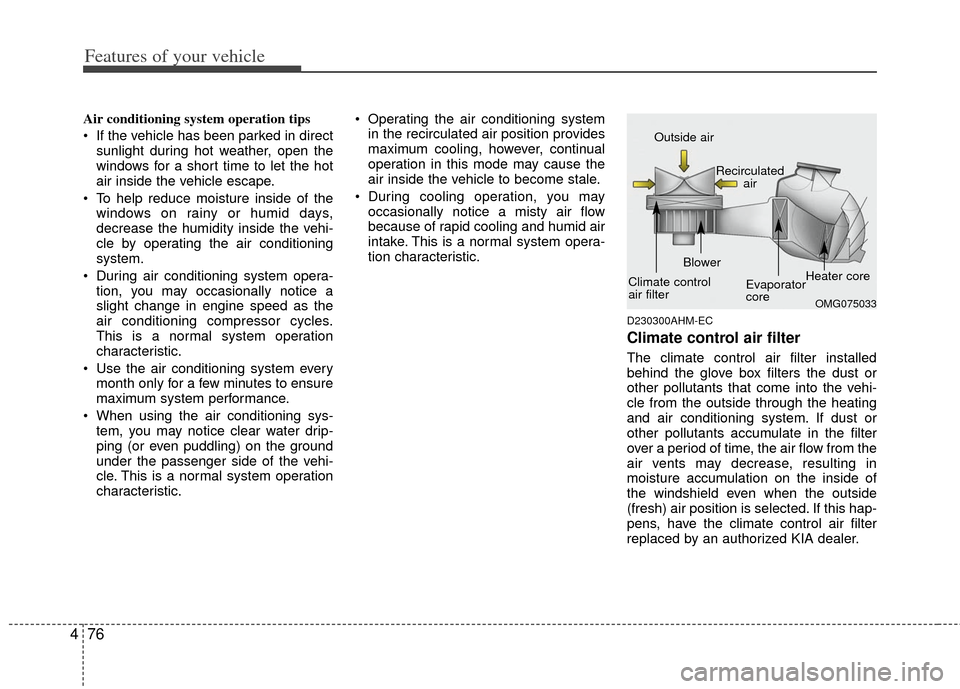
Features of your vehicle
76
4
Air conditioning system operation tips
If the vehicle has been parked in direct
sunlight during hot weather, open the
windows for a short time to let the hot
air inside the vehicle escape.
To help reduce moisture inside of the windows on rainy or humid days,
decrease the humidity inside the vehi-
cle by operating the air conditioning
system.
During air conditioning system opera- tion, you may occasionally notice a
slight change in engine speed as the
air conditioning compressor cycles.
This is a normal system operation
characteristic.
Use the air conditioning system every month only for a few minutes to ensure
maximum system performance.
When using the air conditioning sys- tem, you may notice clear water drip-
ping (or even puddling) on the ground
under the passenger side of the vehi-
cle. This is a normal system operation
characteristic. Operating the air conditioning system
in the recirculated air position provides
maximum cooling, however, continual
operation in this mode may cause the
air inside the vehicle to become stale.
During cooling operation, you may occasionally notice a misty air flow
because of rapid cooling and humid air
intake. This is a normal system opera-
tion characteristic.
D230300AHM-EC
Climate control air filter
The climate control air filter installed
behind the glove box filters the dust or
other pollutants that come into the vehi-
cle from the outside through the heating
and air conditioning system. If dust or
other pollutants accumulate in the filter
over a period of time, the air flow from the
air vents may decrease, resulting in
moisture accumulation on the inside of
the windshield even when the outside
(fresh) air position is selected. If this hap-
pens, have the climate control air filter
replaced by an authorized KIA dealer.
OMG075033
Outside air
Recirculatedair
Climate control
air filter Blower
Evaporator
coreHeater core
Page 158 of 353

Features of your vehicle
80
4
D240200ATD
Manual heating and air condition-
ing
The heating and cooling system can be
controlled manually by pushing buttons
other than the AUTO button. In this case,
the system works sequentially according
to the order of buttons selected.
1. Start the engine.
2. Set the mode to the desired position.
To improve the effectiveness of heat-ing and cooling :
- Heating:
- Cooling:
3. Set the temperature control to the desired position.
4. Set the air intake control to the outside (fresh) air or recirculated air position.
5. Set the fan speed control to the desired speed.
6. If air conditioning is desired, turn the air conditioning system on.
Press the AUTO button in order to con-
vert to full automatic control of the sys-
tem.
D240201ATD
Mode selection
The mode selection button controls the
direction of the air flow through the venti-
lation system.
Every time you press the mode selection
button, the mode will change as follows:
Refer to the illustration in the “Manual cli-
mate control system”. Face-Level (B, D)
Air flow is directed toward the upper body
and face. Additionally, each outlet can be
controlled to direct the air discharged
from the outlet.
Bi-Level (B, D, C, E)
Air flow is discharged towards the face
and floor.
Floor-Level (C, E, A, D)
Most of the air flow is directed to the
floor, with a small amount of the air being
directed to the windshield and side win-
dow defroster.
Floor/Defrost-Level (A, C, E, D)
Most of the air flow is directed to the floor
and the windshield with a small amount
directed to the side window defrosters.
OTD049103
Page 212 of 353
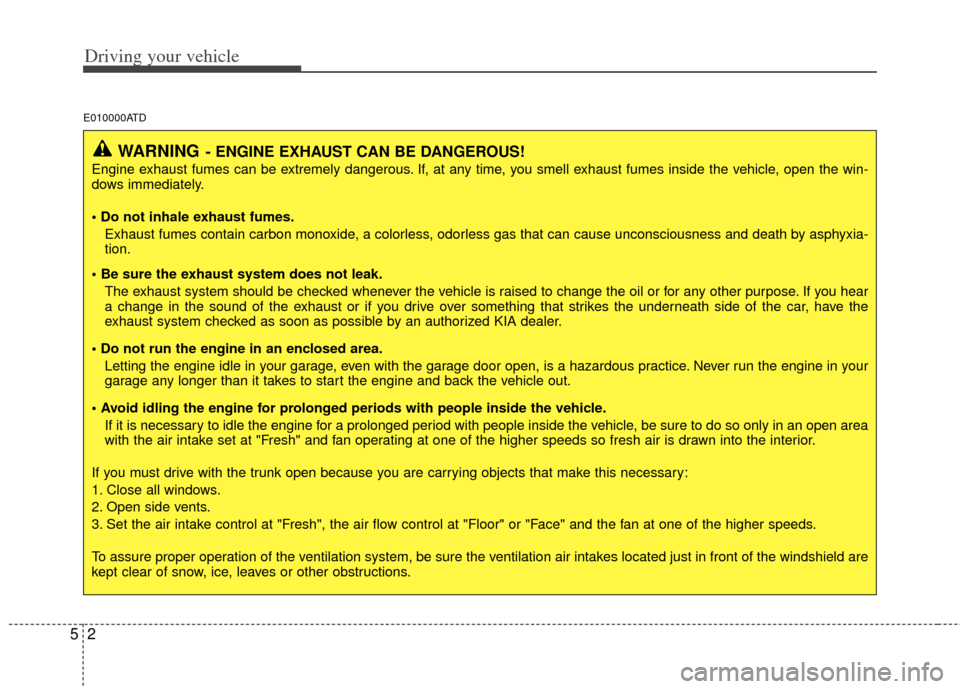
Driving your vehicle
25
E010000ATD
WARNING- ENGINE EXHAUST CAN BE DANGEROUS!
Engine exhaust fumes can be extremely dangerous. If, at any time, you smell exhaust fumes inside the vehicle, open the win-
dows immediately.
• Do not inhale exhaust fumes.Exhaust fumes contain carbon monoxide, a colorless, odorless gas that can cause unconsciousness and death by asphyxia-
tion.
The exhaust system should be checked whenever the vehicle is raised to change the oil or for any other purpose. If you hear
a change in the sound of the exhaust or if you drive over something that strikes the underneath side of the car, have the
exhaust system checked as soon as possible by an authorized KIA dealer.
Letting the engine idle in your garage, even with the garage door open, is a hazardous practice. Never run the engine in your
garage any longer than it takes to start the engine and back the vehicle out.
If it is necessary to idle the engine for a prolonged period with people inside the vehicle, be sure to do so only in an open a rea
with the air intake set at "Fresh" and fan operating at one of the higher speeds so fresh air is drawn into the interior.
If you must drive with the trunk open because you are carrying objects that make this necessary:
1. Close all windows.
2. Open side vents.
3. Set the air intake control at "Fresh", the air flow control at "Floor" or "Face" and the fan at one of the higher speeds.
To assure proper operation of the ventilation system, be sure the ventilation air intakes located just in front of the windshie ld are
kept clear of snow, ice, leaves or other obstructions.
Page 287 of 353
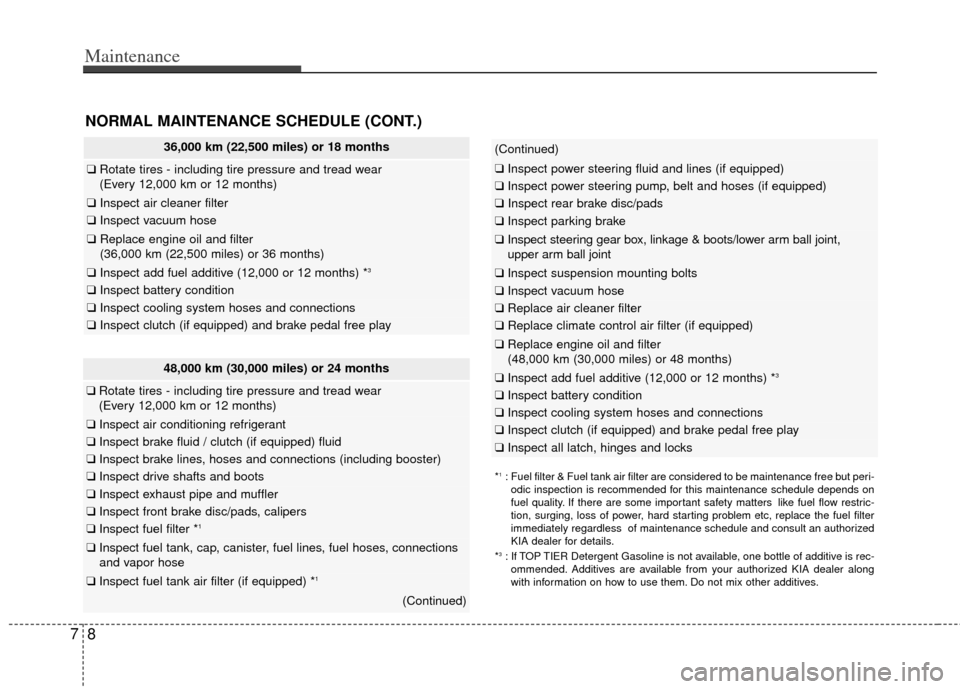
Maintenance
87
36,000 km (22,500 miles) or 18 months
❑Rotate tires - including tire pressure and tread wear
(Every 12,000 km or 12 months)
❑ Inspect air cleaner filter
❑Inspect vacuum hose
❑Replace engine oil and filter
(36,000 km (22,500 miles) or 36 months)
❑ Inspect add fuel additive (12,000 or 12 months) *3
❑Inspect battery condition
❑Inspect cooling system hoses and connections
❑Inspect clutch (if equipped) and brake pedal free play
NORMAL MAINTENANCE SCHEDULE (CONT.)
48,000 km (30,000 miles) or 24 months
❑Rotate tires - including tire pressure and tread wear
(Every 12,000 km or 12 months)
❑ Inspect air conditioning refrigerant
❑Inspect brake fluid / clutch (if equipped) fluid
❑ Inspect brake lines, hoses and connections (including booster)
❑Inspect drive shafts and boots
❑Inspect exhaust pipe and muffler
❑Inspect front brake disc/pads, calipers
❑Inspect fuel filter *1
❑Inspect fuel tank, cap, canister, fuel lines, fuel hoses, connections
and vapor hose
❑Inspect fuel tank air filter (if equipped) *1
(Continued)
(Continued)
❑Inspect power steering fluid and lines (if equipped)
❑Inspect power steering pump, belt and hoses (if equipped)
❑ Inspect rear brake disc/pads
❑Inspect parking brake
❑Inspect steering gear box, linkage & boots/lower arm ball joint,
upper arm ball joint
❑Inspect suspension mounting bolts
❑ Inspect vacuum hose
❑Replace air cleaner filter
❑ Replace climate control air filter (if equipped)
❑Replace engine oil and filter
(48,000 km (30,000 miles) or 48 months)
❑ Inspect add fuel additive (12,000 or 12 months) *3
❑Inspect battery condition
❑Inspect cooling system hoses and connections
❑Inspect clutch (if equipped) and brake pedal free play
❑Inspect all latch, hinges and locks
*1: Fuel filter & Fuel tank air filter are considered to be maintenance free\
but peri-
odic inspection is recommended for this maintenance schedule depends on
fuel quality. If there are some important safety matters like fuel flow restric-
tion, surging, loss of power, hard starting problem etc, replace the fuel filter
immediately regardless of maintenance schedule and consult an authorized
KIA dealer for details.
*
3: If TOP TIER Detergent Gasoline is not available, one bottle of additive is rec- ommended. Additives are available from your authorized KIA dealer along
with information on how to use them. Do not mix other additives.
Page 289 of 353
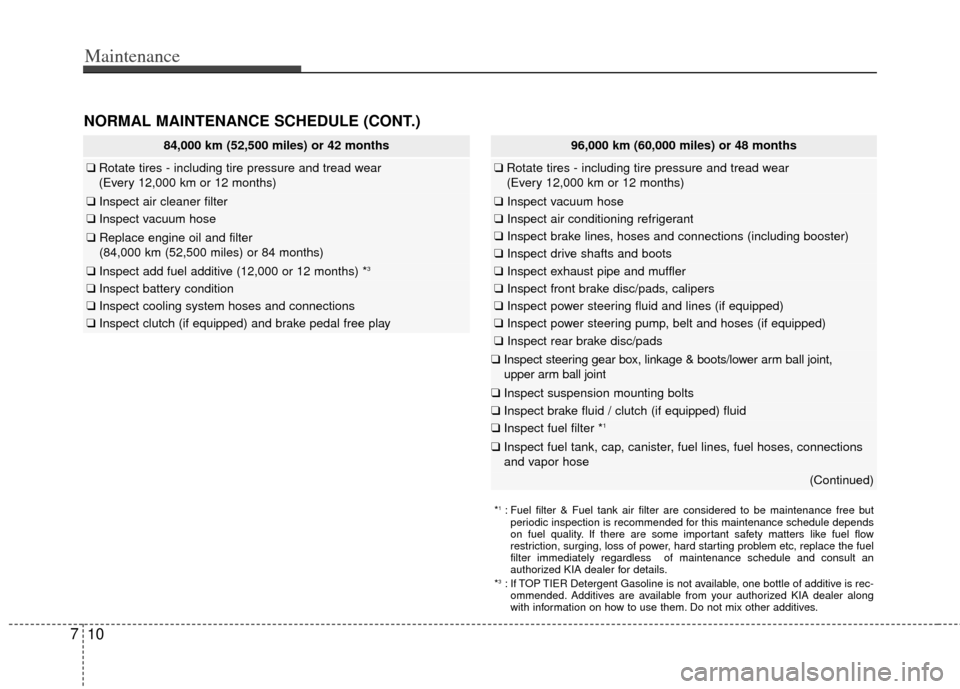
Maintenance
7
NORMAL MAINTENANCE SCHEDULE (CONT.)
84,000 km (52,500 miles) or 42 months
❑Rotate tires - including tire pressure and tread wear
(Every 12,000 km or 12 months)
❑ Inspect air cleaner filter
❑Inspect vacuum hose
❑Replace engine oil and filter
(84,000 km (52,500 miles) or 84 months)
❑ Inspect add fuel additive (12,000 or 12 months) *3
❑Inspect battery condition
❑Inspect cooling system hoses and connections
❑Inspect clutch (if equipped) and brake pedal free play
96,000 km (60,000 miles) or 48 months
❑Rotate tires - including tire pressure and tread wear
(Every 12,000 km or 12 months)
❑ Inspect vacuum hose
❑Inspect air conditioning refrigerant
❑Inspect brake lines, hoses and connections (including booster)
❑Inspect drive shafts and boots
❑Inspect exhaust pipe and muffler
❑Inspect front brake disc/pads, calipers
❑Inspect power steering fluid and lines (if equipped)
❑Inspect power steering pump, belt and hoses (if equipped)
❑ Inspect rear brake disc/pads
❑Inspect steering gear box, linkage & boots/lower arm ball joint,
upper arm ball joint
❑ Inspect suspension mounting bolts
❑Inspect brake fluid / clutch (if equipped) fluid
❑Inspect fuel filter *1
❑Inspect fuel tank, cap, canister, fuel lines, fuel hoses, connections
and vapor hose
(Continued)
*1: Fuel filter & Fuel tank air filter are considered to be maintenance free\
but
periodic inspection is recommended for this maintenance schedule depends
on fuel quality. If there are some important safety matters like fuel flow
restriction, surging, loss of power, hard starting problem etc, replace the fuel
filter immediately regardless of maintenance schedule and consult an
authorized KIA dealer for details.
*
3: If TOP TIER Detergent Gasoline is not available, one bottle of additive is rec- ommended. Additives are available from your authorized KIA dealer along
with information on how to use them. Do not mix other additives.
10
Page 290 of 353

711
Maintenance
(Continued)
❑Inspect fuel tank air filter (if equipped) *1
❑Inspect parking brake
❑Inspect valve clearance *2
❑Replace air cleaner filter
❑Replace climate control air filter (if equipped)
❑Replace engine oil and filter
(96,000 km (60,000 miles) or 96 months)
❑Inspect drive belt *4
(First, 96,000 km or 72 months
after every 24,000 km or 24 months)
❑ Inspect add fuel additive (12,000 or 12 months) *3
❑Inspect battery condition
❑Inspect cooling system hoses and connections
❑Inspect clutch (if equipped) and brake pedal free play
❑Inspect all latch, hinges and locks
*1: Fuel filter & Fuel tank air filter are considered to be maintenance free\
but
periodic inspection is recommended for this maintenance schedule depends
on fuel quality. If there are some important safety matters like fuel flow
restriction, surging, loss of power, hard starting problem etc, replace the fuel
filter immediately regardless of maintenance schedule and consult an
authorized KIA dealer for details.
*
2: Inspect for excessive tappet noise and/or engine vibration and adjust if nec- essary.
*
3: If TOP TIER Detergent Gasoline is not available, one bottle of additive is rec- ommended. Additives are available from your authorized KIA dealer along
with information on how to use them. Do not mix other additives.
*
4: The drive belt should be replaced when cracks occur or tension is reduced excessively.
NORMAL MAINTENANCE SCHEDULE (CONT.)
Page 292 of 353
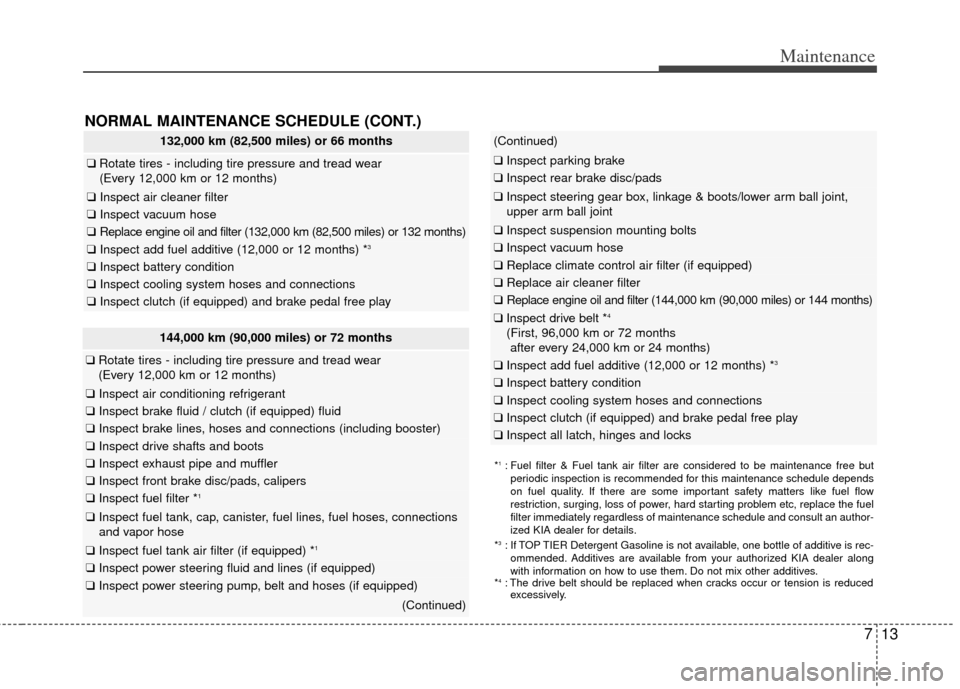
713
Maintenance
NORMAL MAINTENANCE SCHEDULE (CONT.)
132,000 km (82,500 miles) or 66 months
❑Rotate tires - including tire pressure and tread wear
(Every 12,000 km or 12 months)
❑ Inspect air cleaner filter
❑Inspect vacuum hose
❑Replace engine oil and filter (132,000 km (82,500 miles) or 132 month\
s)
❑ Inspect add fuel additive (12,000 or 12 months) *3
❑Inspect battery condition
❑Inspect cooling system hoses and connections
❑Inspect clutch (if equipped) and brake pedal free play
144,000 km (90,000 miles) or 72 months
❑Rotate tires - including tire pressure and tread wear
(Every 12,000 km or 12 months)
❑ Inspect air conditioning refrigerant
❑Inspect brake fluid / clutch (if equipped) fluid
❑ Inspect brake lines, hoses and connections (including booster)
❑Inspect drive shafts and boots
❑Inspect exhaust pipe and muffler
❑Inspect front brake disc/pads, calipers
❑Inspect fuel filter *1
❑Inspect fuel tank, cap, canister, fuel lines, fuel hoses, connections
and vapor hose
❑ Inspect fuel tank air filter (if equipped) *1
❑Inspect power steering fluid and lines (if equipped)
❑Inspect power steering pump, belt and hoses (if equipped)
(Continued)
(Continued)
❑ Inspect parking brake
❑Inspect rear brake disc/pads
❑Inspect steering gear box, linkage & boots/lower arm ball joint,
upper arm ball joint
❑ Inspect suspension mounting bolts
❑Inspect vacuum hose
❑Replace climate control air filter (if equipped)
❑Replace air cleaner filter
❑Replace engine oil and filter (144,000 km (90,000 miles) or 144 month\
s)
❑Inspect drive belt *4
(First, 96,000 km or 72 months
after every 24,000 km or 24 months)
❑ Inspect add fuel additive (12,000 or 12 months) *3
❑Inspect battery condition
❑Inspect cooling system hoses and connections
❑Inspect clutch (if equipped) and brake pedal free play
❑Inspect all latch, hinges and locks
*1: Fuel filter & Fuel tank air filter are considered to be maintenance free\
but
periodic inspection is recommended for this maintenance schedule depends
on fuel quality. If there are some important safety matters like fuel flow
restriction, surging, loss of power, hard starting problem etc, replace the fuel
filter immediately regardless of maintenance schedule and consult an aut\
hor-
ized KIA dealer for details.
*
3: If TOP TIER Detergent Gasoline is not available, one bottle of additive is rec- ommended. Additives are available from your authorized KIA dealer along
with information on how to use them. Do not mix other additives.
*
4: The drive belt should be replaced when cracks occur or tension is reduced excessively.
Page 294 of 353

15
Maintenance
NORMAL MAINTENANCE SCHEDULE (CONT.)
180,000 km (112,500 miles) or 90 months
❑Rotate tires - including tire pressure and tread wear
(Every 12,000 km or 12 months)
❑ Inspect air cleaner filter
❑Inspect vacuum hose
❑Replace engine oil and filter
(180,000 km (112,500 miles) or 180 months)
❑ Inspect add fuel additive (12,000 or 12 months) *3
❑Inspect battery condition
❑Inspect cooling system hoses and connections
❑Inspect clutch (if equipped) and brake pedal free play
❑Inspect manual transaxle fluid (if equipped)
(Every 60,000 km or 48 months)
192,000 km (120,000 miles) or 96 months
❑Rotate tires - including tire pressure and tread wear
(Every 12,000 km or 12 months)
❑ Inspect air conditioning refrigerant
❑Inspect brake fluid / clutch (if equipped) fluid
❑ Inspect brake lines, hoses and connections (including booster)
❑Inspect drive shafts and boots
❑Inspect exhaust pipe and muffler
❑Inspect front brake disc/pads, calipers
❑Inspect fuel filter *1
❑Inspect fuel tank, cap, canister, fuel lines, fuel hoses, connections
and vapor hose
(Continued)
(Continued)
❑ Inspect fuel tank air filter (if equipped) *1
❑Inspect parking brake
❑Inspect power steering fluid and lines (if equipped)
❑Inspect power steering pump, belt and hoses (if equipped)
❑ Inspect rear brake disc/pads
❑Inspect steering gear box, linkage & boots/lower arm ball joint,
upper arm ball joint
❑ Inspect suspension mounting bolts
❑Inspect vacuum hose
❑Inspect vapor hose and fuel filler cap
❑Inspect valve clearance *2
❑Replace air cleaner filter
❑Replace climate control air filter (if equipped)
❑Replace engine coolant *5(First, 192,000 km (120,000 miles) or
120 months after every 48,000 km (30,000 miles) or 24 months)
(Continued)
*1: Fuel filter & Fuel tank air filter are considered to be maintenance free\
but periodic inspection is recommended for this maintenance schedule depends
on fuel quality. If there are some important safety matters like fuel flow
restriction, surging, loss of power, hard starting problem etc, replace the fuel
filter immediately regardless of maintenance schedule and consult an aut\
hor-
ized KIA dealer for details.
*
2: Inspect for excessive tappet noise and/or engine vibration and adjust if nec- essary.
*
3: If TOP TIER Detergent Gasoline is not available, one bottle of additive is rec- ommended. Additives are available from your authorized KIA dealer along
with information on how to use them. Do not mix other additives.
*
5: When replacing coolant, use only a qualified coolant additive for your vehicle and never mix hard water in the coolant filled at the factory. An improper
coolant mixture can result in serious malfunction or engine damage.
7
Page 297 of 353
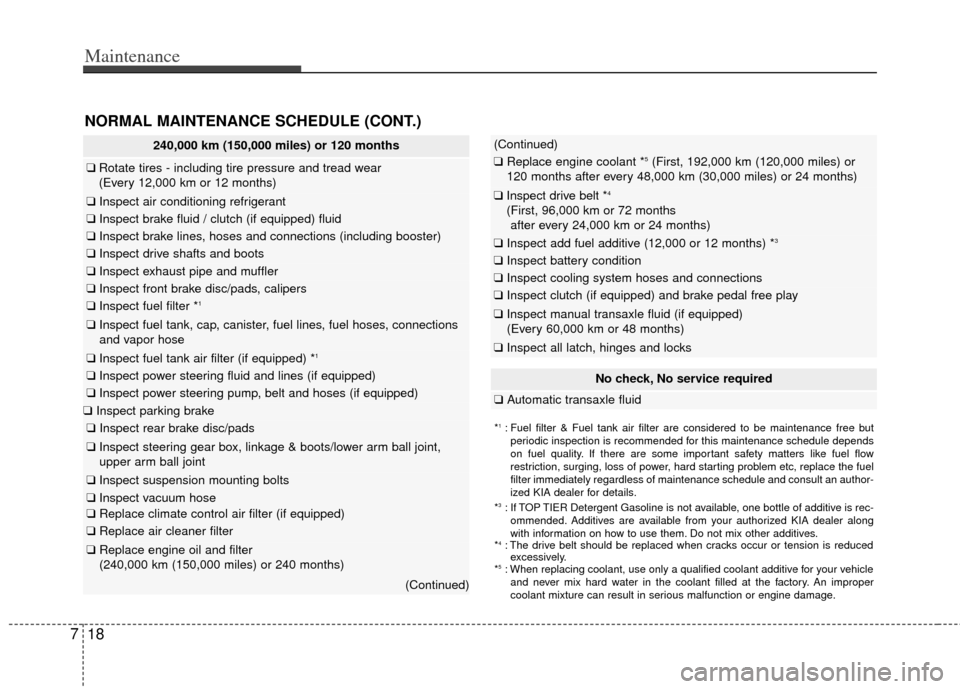
Maintenance
18
7
240,000 km (150,000 miles) or 120 months
❑ Rotate tires - including tire pressure and tread wear
(Every 12,000 km or 12 months)
❑ Inspect air conditioning refrigerant
❑Inspect brake fluid / clutch (if equipped) fluid
❑ Inspect brake lines, hoses and connections (including booster)
❑Inspect drive shafts and boots
❑Inspect exhaust pipe and muffler
❑Inspect front brake disc/pads, calipers
❑Inspect fuel filter *1
❑Inspect fuel tank, cap, canister, fuel lines, fuel hoses, connections
and vapor hose
❑ Inspect fuel tank air filter (if equipped) *1
❑Inspect power steering fluid and lines (if equipped)
❑Inspect power steering pump, belt and hoses (if equipped)
❑ Inspect parking brake
❑Inspect rear brake disc/pads
❑Inspect steering gear box, linkage & boots/lower arm ball joint,
upper arm ball joint
❑ Inspect suspension mounting bolts
❑Inspect vacuum hose
❑Replace climate control air filter (if equipped)
❑Replace air cleaner filter
❑Replace engine oil and filter
(240,000 km (150,000 miles) or 240 months)
(Continued)
(Continued)
❑Replace engine coolant *5(First, 192,000 km (120,000 miles) or
120 months after every 48,000 km (30,000 miles) or 24 months)
❑ Inspect drive belt *4
(First, 96,000 km or 72 months
after every 24,000 km or 24 months)
❑ Inspect add fuel additive (12,000 or 12 months) *3
❑Inspect battery condition
❑Inspect cooling system hoses and connections
❑Inspect clutch (if equipped) and brake pedal free play
❑Inspect manual transaxle fluid (if equipped)
(Every 60,000 km or 48 months)
❑ Inspect all latch, hinges and locks
NORMAL MAINTENANCE SCHEDULE (CONT.)
No check, No service required
❑Automatic transaxle fluid
*1: Fuel filter & Fuel tank air filter are considered to be maintenance free\
but
periodic inspection is recommended for this maintenance schedule depends
on fuel quality. If there are some important safety matters like fuel flow
restriction, surging, loss of power, hard starting problem etc, replace the fuel
filter immediately regardless of maintenance schedule and consult an aut\
hor-
ized KIA dealer for details.
*
3: If TOP TIER Detergent Gasoline is not available, one bottle of additive is rec- ommended. Additives are available from your authorized KIA dealer along
with information on how to use them. Do not mix other additives.
*
4: The drive belt should be replaced when cracks occur or tension is reduced excessively.
*
5: When replacing coolant, use only a qualified coolant additive for your vehicle
and never mix hard water in the coolant filled at the factory. An improper
coolant mixture can result in serious malfunction or engine damage.
Page 310 of 353

731
Maintenance
PARKING BRAKE
G140100ATD
Checking the parking brake
Check the stroke of the parking brake by
counting the number of “clicks’’ heard
while fully applying it from the released
position. Also, the parking brake alone
should securely hold the vehicle on a fair-
ly steep grade. If the stroke is more or
less than specified, have the parking
brake adjusted by an authorized KIA
dealer.
Stroke : 6~8 “clicks’’ at a force of 20 kg (44 lbs, 196 N).
G160100AAM-EC
Filter replacement
It must be replaced when necessary, and
should not be washed.
You can clean the filter when inspecting
the air cleaner element.
Clean the filter by using compressed air. Replace the filter according to the
Maintenance Schedule.
If the vehicle is operated in extremely
dusty or sandy areas, replace the ele- ment more often than the usual recom-mended intervals.
OTD079014
CAUTION
Do not drive with the air cleaner removed; this will result in exces-sive engine wear.
When removing the air cleaner fil- ter, be careful that dust or dirtdoes not enter the air intake, or damage may result.
Use a KIA genuine part. Use of nongenuine part could damagethe air flow sensor.
OTD059010
AIR CLEANER